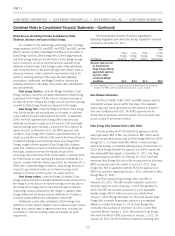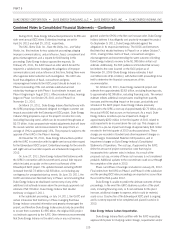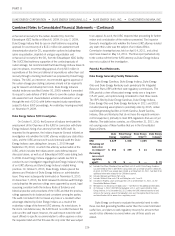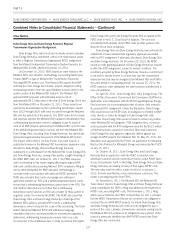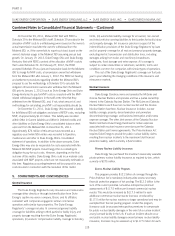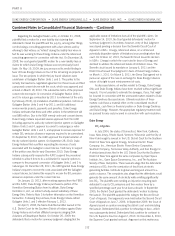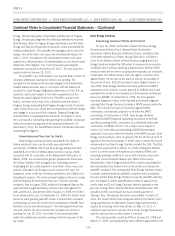Duke Energy 2011 Annual Report Download - page 151
Download and view the complete annual report
Please find page 151 of the 2011 Duke Energy annual report below. You can navigate through the pages in the report by either clicking on the pages listed below, or by using the keyword search tool below to find specific information within the annual report.
PART II
DUKE ENERGY CORPORATION •DUKE ENERGY CAROLINAS, LLC •DUKE ENERGY OHIO, INC. •DUKE ENERGY INDIANA, INC.
Combined Notes to Consolidated Financial Statements – (Continued)
published in the Federal Register. The final rule establishes emission
limits for hazardous air pollutants, including mercury, from new and
existing coal-fired electric generating units. The rule requires sources
to comply with the emission limits by April 16, 2015. Under the
Clean Air Act, permitting authorities have the discretion to grant up to
a 1-year compliance extension, on a case-by-case basis, to sources
that are unable to complete the installation of emission controls
beforethecompliancedeadline.TheDukeEnergyRegistrantsare
evaluating the requirements of the rule and developing strategies for
complying with the rule’s requirements. Strategies to achieve
compliance with the final MATS rules are likely to include installation
of new or upgrades to existing air emission control equipment, the
development of monitoring processes and accelerated retirement of
some coal-fired electric-generating units. Refer to Note 4, Regulatory
Matters, regarding potential plant retirements. Based on a preliminary
review, the cost to the Duke Energy Registrants to comply with the
final regulation will be material.
While the ultimate regulatory requirements for the Duke Energy
Registrants for MATS, Clean Water Act 316(b), CSAPR and CCRs will
not be known until all the rules have been finalized, for planning
purposes, the Duke Energy Registrants currently estimate the cost of
new control equipment that may need to be installed to comply with
this group of rules could total $4.5 billion to $5 billion over the next
10 years. The Duke Energy Registrants will seek regulatory recovery
of amounts incurred in conjunction with these rulings.
Litigation
Duke Energy Carolinas, Duke Energy Ohio and Duke Energy
Indiana
NewSourceReview(NSR).
In 1999-2000, the DOJ, acting on behalf of the EPA and joined
by various citizen groups and states, filed a number of complaints
and notices of violation against multiple utilities across the country for
alleged violations of the NSR provisions of the Clean Air Act (CAA).
Generally, the government alleges that projects performed at various
coal-fired units were major modifications, as defined in the CAA, and
that the utilities violated the CAA when they undertook those projects
without obtaining permits and installing the best available emission
controls for SO2,NO
xand particulate matter. The complaints seek
injunctive relief to require installation of pollution control technology
on various generating units that allegedly violated the CAA, and
unspecified civil penalties in amounts of up to $32,500 per day for
each violation. A number of the Duke Energy Registrants’ plants have
been subject to these allegations. The Duke Energy Registrants assert
that there were no CAA violations because the applicable regulations
do not require permitting in cases where the projects undertaken are
“routine” or otherwise do not result in a net increase in emissions.
In 2000, the government brought a lawsuit against Duke
Energy Carolinas in the U.S. District Court in Greensboro, North
Carolina. The EPA claims that 29 projects performed at 25 of Duke
Energy Carolinas’ coal-fired units violate these NSR provisions. Three
environmental groups have intervened in the case. In August 2003,
the trial court issued a summary judgment opinion adopting Duke
Energy Carolinas’ legal positions on the standard to be used for
measuring an increase in emissions, and granted judgment in favor
of Duke Energy Carolinas. The trial court’s decision was appealed and
ultimately reversed and remanded for trial by the U.S. Supreme
Court. At trial, Duke Energy Carolinas will continue to assert that the
projects were routine or not projected to increase emissions. On
February 11, 2011, the trial judge held an initial status conference
and on March 22, 2011, the judge entered an interim scheduling
order. The parties have filed a stipulation in which the United States
and Plaintiff-Intervenors have dismissed with prejudice 16 claims. In
exchange, Duke Energy Carolinas dismissed certain affirmative
defenses. The parties have filed motions for summary judgment on
the remaining claims. No trial date has been set, but a trial is not
expected until the second half of 2012, at the earliest.
In November 1999, the U.S. brought a lawsuit in the U.S.
Federal District Court for the Southern District of Indiana against
Cinergy, Duke Energy Ohio, and Duke Energy Indiana alleging
various violations of the CAA for various projects at six owned and
co-owned generating stations in the Midwest. Three northeast states
and two environmental groups intervened in the case. A jury verdict
was returned on May 22, 2008. The jury found in favor of Cinergy,
Duke Energy Ohio and Duke Energy Indiana on all but three units at
Duke Energy Indiana’s Wabash River Station, including Duke Energy
Indiana’s Gallagher Station units discussed below. Additionally, the
plaintiffs had claimed that these were a violation of an Administrative
Consent Order entered into in 1998 between the EPA and Cinergy
relating to alleged violations of Ohio’s State Implementation Plan
provisions governing particulate matter at Duke Energy Ohio’s W.C.
Beckjord Station. On May 29, 2009, the court issued its remedy
ruling for violations previously established at the Wabash River and
W.C. Beckjord Stations and ordered the following relief: (i) Wabash
River Units 2, 3 and 5 to be permanently retired by September 30,
2009; (ii) surrender of SO2allowances equal to the emissions from
Wabash River Units 2, 3 and 5 from May 22, 2008 through
September 30, 2009; (iii) civil penalty in the amount of $687,500
for W.C. Beckjord violations; and (iv) installation of a particulate
continuous emissions monitoring system at W.C. Beckjord Units 1
and 2. The civil penalty has been paid. On October 12, 2010, the
Seventh Circuit Court of Appeals issued a decision reversing the trial
court and ordered issuance of judgment in favor of Cinergy (USA v.
Cinergy), which includes Duke Energy Indiana and Duke Energy
Ohio. The plaintiff’s motion for rehearing was denied on
December 29, 2010. On January 6, 2011, the mandate from the
Seventh Circuit was issued returning the case to the District Court
and on April 15, 2011, the District Court issued its Final Amended
Judgment in favor of Cinergy. Plaintiffs did not file a petition for
certiorari with the United State Supreme Court prior to the March 29,
2011 filing deadline. This ruling allowed Wabash River Units 2, 3
and 5 to be placed back into service.
131


